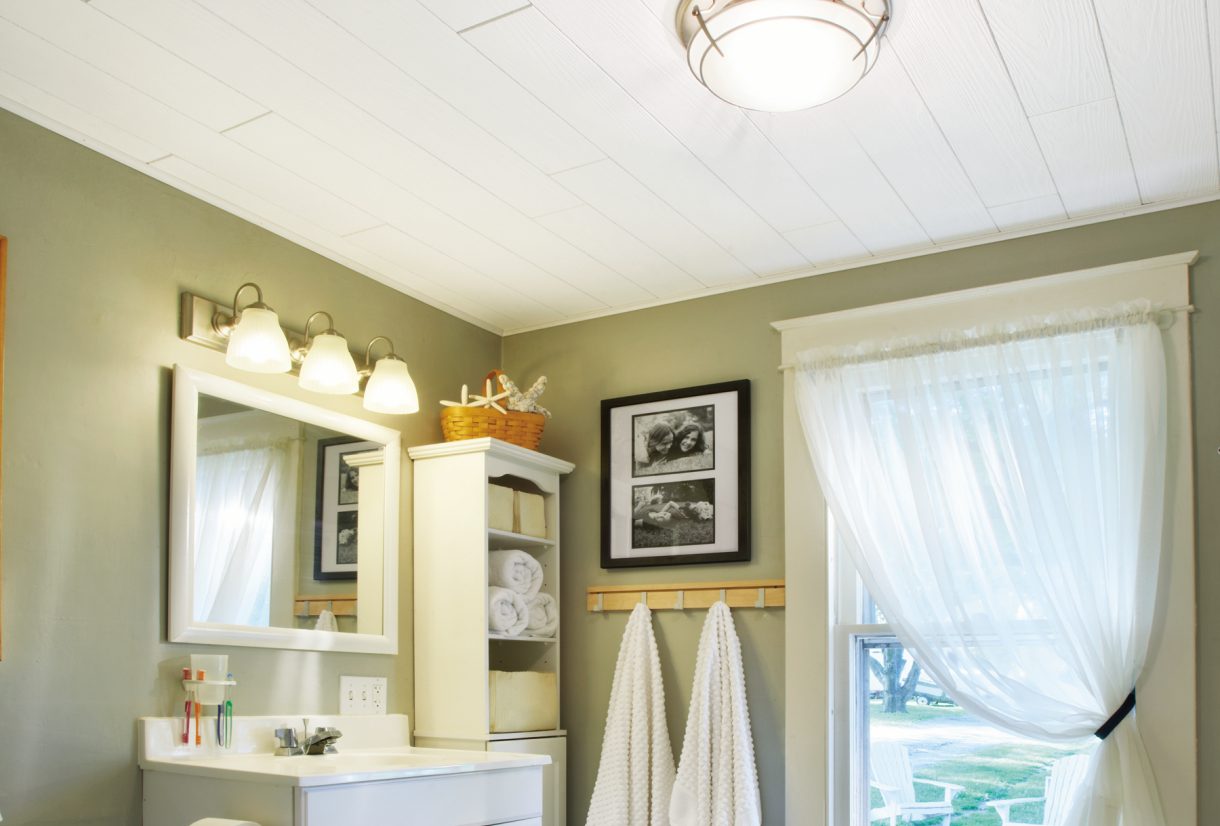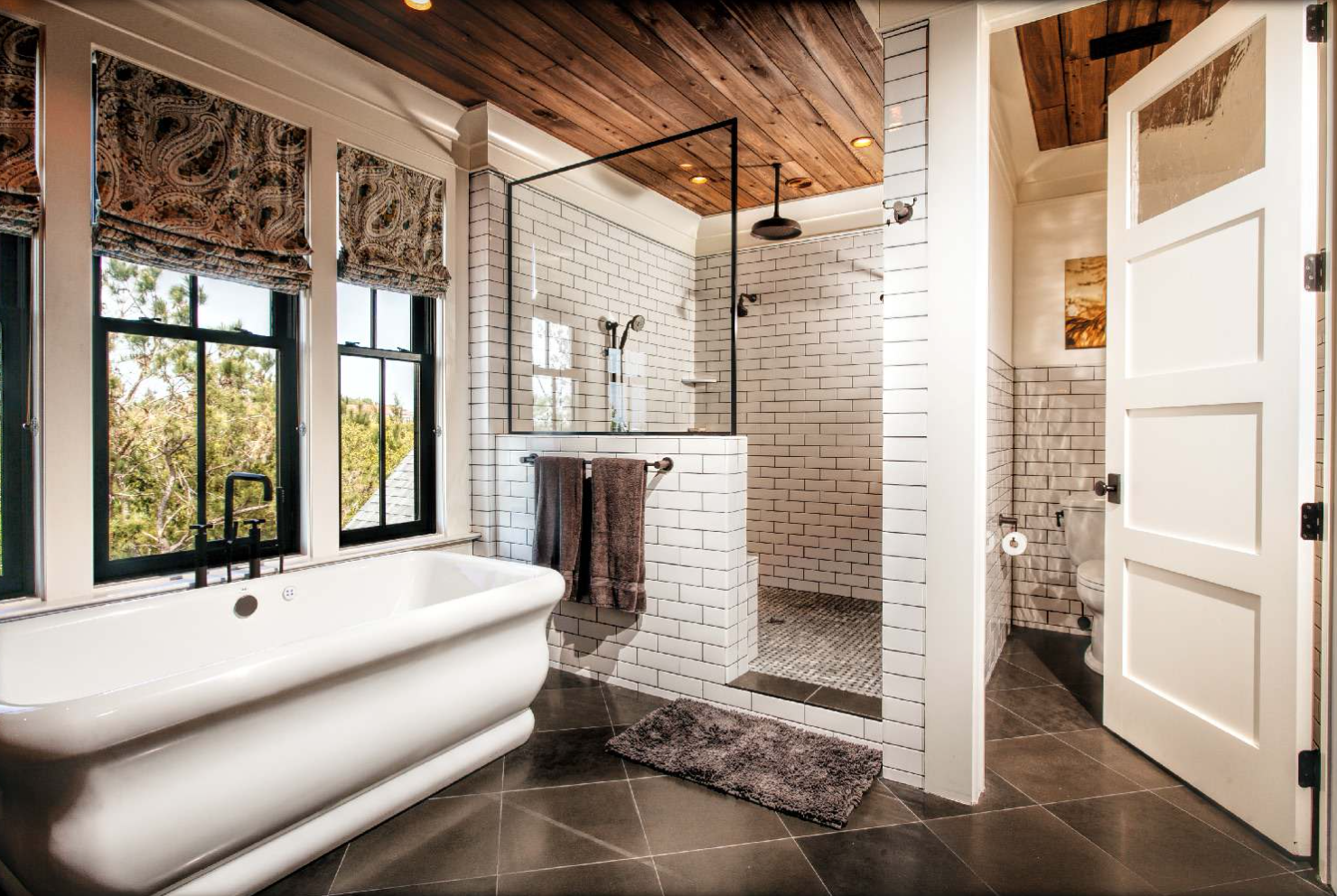Aesthetic and Design Considerations: Wood Plank Bathroom Ceiling

The choice of wood plank style and finish for a bathroom ceiling can significantly influence the overall aesthetic and mood of the space. From rustic charm to modern elegance, wood planks offer a versatile canvas for creating a unique and inviting bathroom environment.
Impact of Wood Plank Ceilings on Bathroom Ambiance and Mood
Wood plank ceilings can transform a bathroom’s ambiance and mood, creating a sense of warmth, tranquility, or sophistication, depending on the chosen style and finish. The natural texture and color variations of wood can add depth and character to the space, while the visual appeal of the planks can evoke a sense of rustic charm, modern elegance, or minimalist simplicity.
- Rustic Charm: Reclaimed wood planks with a distressed finish can create a rustic and cozy atmosphere, reminiscent of a cozy cabin or farmhouse. The imperfections and natural variations in the wood add to the charm and character of the space.
- Modern Elegance: Smooth, polished wood planks in a light or neutral color can create a clean and sophisticated look that complements modern bathroom fixtures and décor.
- Minimalist Simplicity: Unvarnished, natural wood planks in a light or medium shade can create a minimalist and airy feel. The simplicity of the wood allows other elements in the bathroom to take center stage.
Comparison of Natural Wood Planks and Engineered Wood Planks
Natural wood planks offer unique character and durability, while engineered wood planks provide cost-effectiveness and stability. The choice between these options depends on factors such as budget, desired aesthetic, and bathroom size.
- Natural Wood Planks: Natural wood planks are sourced from solid wood and exhibit unique grain patterns, color variations, and knots. They offer a timeless and authentic look but can be more expensive and prone to warping or cracking in humid environments.
- Engineered Wood Planks: Engineered wood planks are made from layers of wood veneer or wood fibers bonded together. They offer greater stability and moisture resistance compared to natural wood planks, making them suitable for bathroom ceilings. Engineered wood planks can mimic the appearance of natural wood but may lack the unique character of solid wood.
Designing a Bathroom Ceiling with Wood Planks
Designing a bathroom ceiling with wood planks involves considering the overall theme and style of the bathroom, the size and shape of the space, and the desired ambiance.
- Rustic Bathroom: A rustic bathroom can feature reclaimed wood planks with a distressed finish, exposed beams, and natural stone accents. The wood planks can be installed in a random pattern or in a herringbone pattern to add visual interest.
- Modern Bathroom: A modern bathroom can feature smooth, polished wood planks in a light or neutral color. The planks can be installed in a straight pattern or in a geometric pattern to create a clean and contemporary look.
- Minimalist Bathroom: A minimalist bathroom can feature unvarnished, natural wood planks in a light or medium shade. The planks can be installed in a simple straight pattern to create a clean and airy feel.
Practical Aspects and Installation

Installing a wood plank bathroom ceiling requires careful planning and execution to ensure both aesthetics and durability. The unique environment of a bathroom, characterized by high humidity and moisture, necessitates specific considerations and techniques for successful installation. This section delves into the practical aspects of installing wood plank ceilings in bathrooms, providing a step-by-step guide and highlighting crucial techniques for achieving a long-lasting and visually appealing result.
Step-by-Step Installation Guide
Installing wood plank ceilings in bathrooms involves several steps, each requiring careful attention to detail. This guide Artikels the essential steps for a successful installation:
- Preparation: Begin by preparing the existing ceiling surface. This involves removing any existing fixtures, such as light fixtures or fans. Next, ensure the surface is clean and free of debris, dust, or loose materials. Patch any cracks or imperfections using a suitable patching compound and allow it to dry completely.
- Framing: Install the framing for the wood plank ceiling. For direct attachment, use furring strips or joists, ensuring they are level and properly spaced for the chosen wood planks. For suspended grid systems, install the grid structure according to manufacturer specifications. Ensure all framing is securely attached to the existing ceiling and meets local building codes.
- Installation: Begin installing the wood planks, starting from one corner of the room. Depending on the chosen installation method, use nails, screws, or clips to attach the planks to the framing. Ensure each plank is properly aligned and flush with the adjacent planks. For direct attachment, consider using a pneumatic nail gun for faster and more efficient installation.
- Finishing: After installing all planks, finish the ceiling by adding trim or moldings around the perimeter. Use a high-quality wood filler to fill any gaps or nail holes. Sand the filled areas smooth and prime the entire ceiling before painting or staining. Apply a sealant to the edges and exposed ends of the planks to prevent moisture from penetrating the wood.
Challenges and Considerations
Installing wood plank ceilings in bathrooms presents specific challenges due to the humid environment. Understanding these challenges and implementing appropriate solutions is crucial for achieving a successful installation.
- Moisture: Bathrooms are inherently humid environments, posing a significant risk of moisture damage to wood planks. Moisture can lead to warping, swelling, and mold growth, compromising the structural integrity and aesthetics of the ceiling.
- Ventilation: Adequate ventilation is essential for minimizing humidity levels in bathrooms. Ensure the bathroom has a properly functioning exhaust fan to remove moisture-laden air. Consider installing additional ventilation systems if needed, especially in bathrooms with limited natural ventilation.
- Water Damage: Accidental water spills or leaks can severely damage wood plank ceilings. Implement preventative measures, such as using waterproof sealant and ensuring proper plumbing installation. Regularly inspect the ceiling for signs of water damage and address any issues promptly.
Sealing and Protection, Wood plank bathroom ceiling
Proper sealing and protection are crucial for preventing moisture damage and mold growth in wood plank bathroom ceilings. Here are some tips for ensuring long-term durability:
- Water-Resistant Finishes: Apply a water-resistant finish to the wood planks before installation. This can include a sealant, paint, or stain specifically designed for humid environments. Ensure the finish is properly applied, covering all surfaces and edges of the planks.
- Waterproof Membrane: Consider installing a waterproof membrane beneath the wood planks. This barrier prevents moisture from reaching the wood, providing an additional layer of protection. Ensure the membrane is properly sealed and installed according to manufacturer instructions.
- Regular Maintenance: Regularly inspect the ceiling for signs of moisture damage, such as warping, swelling, or discoloration. Clean the ceiling periodically with a mild cleaning solution and allow it to dry completely. Address any issues promptly to prevent further damage.
Installation Methods
Different installation methods offer distinct advantages and disadvantages. Understanding these differences can help you choose the most suitable method for your specific needs.
| Installation Method | Pros | Cons |
|---|---|---|
| Direct Attachment | Cost-effective, simpler installation, less space requirement | More susceptible to moisture damage, requires careful planning for ceiling joist spacing |
| Suspended Grid | More moisture-resistant, allows for easier access to plumbing or electrical wiring, offers sound insulation | More expensive, requires more space, potentially more complex installation |
Maintenance and Care

Wood plank bathroom ceilings, while aesthetically pleasing and durable, require proper care and maintenance to preserve their beauty and extend their lifespan. Regular cleaning and attention to potential issues will ensure that your bathroom ceiling remains a stunning feature for years to come.
Cleaning and Stain Removal
Regular cleaning is crucial to maintaining the appearance and hygiene of your wood plank bathroom ceiling. Dust and grime can accumulate over time, dulling the wood’s natural sheen and potentially harboring allergens.
- Dusting: Use a soft, dry cloth or a microfiber duster to remove dust regularly. Avoid using abrasive materials that could scratch the wood surface.
- Damp Cleaning: For deeper cleaning, use a damp cloth with mild soap and water. Wring out excess water to prevent soaking the wood, and always dry the surface thoroughly with a clean cloth.
- Stain Removal: For stubborn stains, try a mild cleaning solution specifically designed for wood. Test the solution in an inconspicuous area before applying it to the entire surface. Avoid using harsh chemicals or abrasive cleaners that could damage the wood.
Common Issues and Solutions
Wood plank bathroom ceilings, due to the high humidity and moisture levels in bathrooms, are susceptible to certain issues. Recognizing and addressing these problems promptly can prevent further damage and maintain the ceiling’s integrity.
- Moisture Damage: Excessive moisture can lead to warping, mold growth, and wood rot. Ensure proper ventilation in your bathroom to prevent moisture buildup. Use a dehumidifier if necessary.
- Water Leaks: Leaks from plumbing fixtures or roof damage can cause significant damage to wood plank ceilings. Address any leaks promptly to prevent water damage.
- Insect Infestations: Wood-boring insects can damage wood planks. Regular inspections and professional pest control are essential to prevent infestations.
Longevity and Durability of Wood Plank Types
The longevity and durability of wood plank bathroom ceilings depend heavily on the wood species used. Some woods are naturally more resistant to moisture and decay than others.
- Hardwoods: Hardwoods like oak, maple, and cherry are known for their durability and resistance to moisture. They are suitable for bathroom ceilings and can withstand the humid environment.
- Softwoods: Softwoods like pine and cedar are less resistant to moisture and may require more frequent maintenance. While they can be used for bathroom ceilings, they may require additional protection, such as a sealant, to prevent water damage.
- Exotic Woods: Exotic woods, like teak and mahogany, are highly resistant to moisture and decay. They are excellent choices for bathroom ceilings but can be more expensive.
Restoring and Refinishing
Over time, wood plank bathroom ceilings may show signs of wear and tear, such as scratches, dents, or faded finishes. Restoring and refinishing can rejuvenate the ceiling and extend its lifespan.
- Sanding: Sanding the surface can remove scratches, dents, and old finishes. Use progressively finer grit sandpaper to achieve a smooth finish.
- Staining: Staining can enhance the wood’s natural color or add a new hue. Choose a stain specifically designed for wood and test it in an inconspicuous area before applying it to the entire ceiling.
- Sealing: Sealing the wood protects it from moisture and stains. Use a sealant specifically designed for wood and follow the manufacturer’s instructions carefully.
The rustic charm of a wood plank bathroom ceiling can be enhanced with the right heating solution, ensuring a comfortable and inviting ambiance. While the natural wood provides warmth and character, a well-chosen electric heater can further elevate the space.
To find the perfect model for your needs, explore best electric heater for bathroom options, considering factors like size, safety features, and energy efficiency. With a suitable heater, the warmth of the wood planks will be complemented by the gentle embrace of heat, creating a truly inviting sanctuary.
The rustic charm of a wood plank bathroom ceiling evokes a sense of warmth and natural beauty, often complementing the earthy tones of a wood single bathroom vanity. This combination creates a harmonious aesthetic, where the ceiling’s texture and the vanity’s grain patterns intertwine, fostering a sense of tranquility and grounding the space in nature’s embrace.